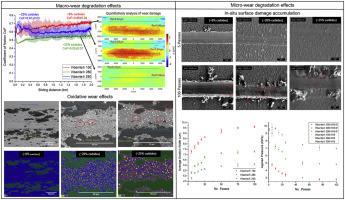Our official English website, www.x-mol.net, welcomes your
feedback! (Note: you will need to create a separate account there.)
Evaluation of wear mechanisms in additive manufactured carbide-rich tool steels
Wear ( IF 5.3 ) Pub Date : 2020-12-01 , DOI: 10.1016/j.wear.2020.203449 Eleftherios Iakovakis , Matthew J. Roy , Mark Gee , Allan Matthews
Wear ( IF 5.3 ) Pub Date : 2020-12-01 , DOI: 10.1016/j.wear.2020.203449 Eleftherios Iakovakis , Matthew J. Roy , Mark Gee , Allan Matthews

|
Abstract Advances in additive manufacturing present the opportunity to design tool steels with higher carbon contents than previously possible with conventional manufacturing. A new class of carbide-rich tool steels with 8 % , 20 % and 25 % volume fraction carbides has been developed using electron beam melting. Reciprocating ball-on-plate dry wear tests were performed to investigate the macro tribological performance of these materials. In-situ scratch wear tests were also performed to assess wear degradation effects at a more fundamental level. The main macro wear mechanism was oxidation with adhered iron oxide islands in all carbide-rich tool steels and the sliding of oxide particles caused three body abrasive wear in the lowest carbide containing material. Surface material removed from the counterbody and formed adhesive iron oxide islands over the oxidized carbide-rich tool steel surface. The compacted oxide islands initially formed at the edges of embedded carbides and then evolved to encompass the entire wear scar. The wear damage was assessed quantitatively through laser profilometry. The lowest wear damage was observed in the 20 % carbide tool steel which also had the lowest coefficient of friction on moving average of 0.52 ± 0.01 compared to the 8 % and 25 % carbide tool steel having on moving average 0.66 ± 0.03 and 0.61 ± 0.03 respectively. In-situ scratch wear tests revealed the potential plastic deformation mechanism of the matrix underneath the oxide film. The deformed matrix of 20 % carbide tool steel generated limited wear debris at the interface of the tribo-system and this is surmised to provide better wear and friction performance among the materials considered.
中文翻译:

增材制造富含碳化物工具钢的磨损机制评估
摘要 增材制造的进步提供了设计碳含量比以前传统制造更高的工具钢的机会。使用电子束熔化技术开发了一类新的富含碳化物的工具钢,其碳化物体积分数为 8%、20% 和 25%。进行往复式球-板干磨损试验以研究这些材料的宏观摩擦学性能。还进行了原位划痕磨损测试,以在更基本的水平上评估磨损退化的影响。主要的宏观磨损机制是所有富含碳化物的工具钢中附着的氧化铁岛氧化,氧化物颗粒的滑动在含碳化物最低的材料中引起三体磨粒磨损。表面材料从对应体上去除,并在富含氧化碳的工具钢表面上形成粘性氧化铁岛。压实的氧化物岛最初形成于嵌入碳化物的边缘,然后演变为包含整个磨痕。通过激光轮廓仪定量评估磨损损伤。在 20 % 硬质合金工具钢中观察到最低的磨损损伤,与 8 % 和 25 % 硬质合金工具钢的移动平均摩擦系数为 0.66 ± 0.03 和 0.61 ± 0.03 相比,其移动平均摩擦系数也最低为 0.52 ± 0.01分别。原位划痕磨损测试揭示了氧化膜下方基体的潜在塑性变形机制。
更新日期:2020-12-01
中文翻译:

增材制造富含碳化物工具钢的磨损机制评估
摘要 增材制造的进步提供了设计碳含量比以前传统制造更高的工具钢的机会。使用电子束熔化技术开发了一类新的富含碳化物的工具钢,其碳化物体积分数为 8%、20% 和 25%。进行往复式球-板干磨损试验以研究这些材料的宏观摩擦学性能。还进行了原位划痕磨损测试,以在更基本的水平上评估磨损退化的影响。主要的宏观磨损机制是所有富含碳化物的工具钢中附着的氧化铁岛氧化,氧化物颗粒的滑动在含碳化物最低的材料中引起三体磨粒磨损。表面材料从对应体上去除,并在富含氧化碳的工具钢表面上形成粘性氧化铁岛。压实的氧化物岛最初形成于嵌入碳化物的边缘,然后演变为包含整个磨痕。通过激光轮廓仪定量评估磨损损伤。在 20 % 硬质合金工具钢中观察到最低的磨损损伤,与 8 % 和 25 % 硬质合金工具钢的移动平均摩擦系数为 0.66 ± 0.03 和 0.61 ± 0.03 相比,其移动平均摩擦系数也最低为 0.52 ± 0.01分别。原位划痕磨损测试揭示了氧化膜下方基体的潜在塑性变形机制。











































 京公网安备 11010802027423号
京公网安备 11010802027423号